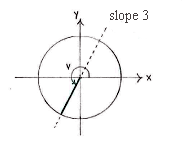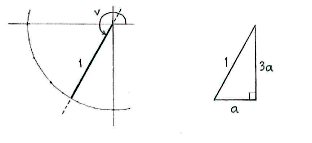Lösung 4.3:6c
Aus Online Mathematik Brückenkurs 1
K (Lösning 4.3:6c moved to Solution 4.3:6c: Robot: moved page) |
|||
| Zeile 1: | Zeile 1: | ||
| - | {{ | + | Because the angle |
| - | < | + | <math>v</math> |
| - | { | + | satisfies |
| - | { | + | <math>\pi \le v\le \frac{3\pi }{2}</math>, |
| - | < | + | <math>v</math> |
| - | { | + | belongs to the third quadrant in the unit circle. Furthermore, |
| + | <math>\text{tan }v=\text{3 }</math> | ||
| + | gives that the line which corresponds to the angle | ||
| + | <math>v</math> | ||
| + | |||
| + | <math>v</math> | ||
| + | has a gradient of | ||
| + | <math>\text{3}</math>. | ||
| + | |||
[[Image:4_3_6_c1.gif|center]] | [[Image:4_3_6_c1.gif|center]] | ||
| + | |||
| + | slope 3 | ||
| + | |||
| + | |||
| + | In the third quadrant, we can introduce a right-angled triangle in which the hypotenuse is | ||
| + | <math>\text{1}</math> | ||
| + | and the sides have a | ||
| + | <math>\text{3}:\text{1 }</math> | ||
| + | ratio. | ||
| + | |||
[[Image:4_3_6_c2.gif|center]] | [[Image:4_3_6_c2.gif|center]] | ||
| + | |||
| + | If we now use Pythagoras' theorem on the triangle, we see that the horizontal side | ||
| + | <math>\text{a}</math> | ||
| + | satisfies | ||
| + | |||
| + | |||
| + | <math>a^{2}+\left( 3a \right)^{2}=1^{2}</math> | ||
| + | |||
| + | |||
| + | which gives us that | ||
| + | |||
| + | |||
| + | <math>10a^{2}=1</math> | ||
| + | i.e. | ||
| + | <math>a=\frac{1}{\sqrt{10}}</math> | ||
| + | |||
| + | |||
| + | Thus, the angle | ||
| + | <math>v</math>'s | ||
| + | <math>x</math> | ||
| + | -coordinate is | ||
| + | <math>-\frac{1}{\sqrt{10}}</math> | ||
| + | and | ||
| + | <math>y</math> | ||
| + | -coordinate is | ||
| + | <math>-\frac{3}{\sqrt{10}}</math>, i.e. | ||
| + | |||
| + | <math>\cos v=--\frac{1}{\sqrt{10}}</math> | ||
| + | |||
| + | |||
| + | <math>\sin v=-\frac{3}{\sqrt{10}}</math> | ||
Version vom 09:38, 30. Sep. 2008
Because the angle \displaystyle v satisfies \displaystyle \pi \le v\le \frac{3\pi }{2}, \displaystyle v belongs to the third quadrant in the unit circle. Furthermore, \displaystyle \text{tan }v=\text{3 } gives that the line which corresponds to the angle \displaystyle v
\displaystyle v has a gradient of \displaystyle \text{3}.
slope 3
In the third quadrant, we can introduce a right-angled triangle in which the hypotenuse is
\displaystyle \text{1}
and the sides have a
\displaystyle \text{3}:\text{1 }
ratio.
If we now use Pythagoras' theorem on the triangle, we see that the horizontal side \displaystyle \text{a} satisfies
\displaystyle a^{2}+\left( 3a \right)^{2}=1^{2}
which gives us that
\displaystyle 10a^{2}=1
i.e.
\displaystyle a=\frac{1}{\sqrt{10}}
Thus, the angle
\displaystyle v's
\displaystyle x
-coordinate is
\displaystyle -\frac{1}{\sqrt{10}}
and
\displaystyle y
-coordinate is
\displaystyle -\frac{3}{\sqrt{10}}, i.e.
\displaystyle \cos v=--\frac{1}{\sqrt{10}}
\displaystyle \sin v=-\frac{3}{\sqrt{10}}


